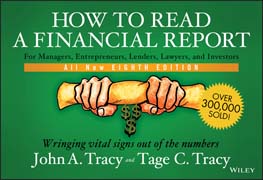
How to Read a Financial Report: Wringing Vital Signs Out of the Numbers
Tracy, John A.
Tracy, Tage
An updated new edition of the comprehensive guide to reading and understanding financial reports Financial reports provide vital information to investors, lenders, and managers. Yet, the financial statements in a financial report seem to be written in a foreign language that only accountants can understand. This new Eighth Edition of How to Read a Financial Report breaks through that language barrier, clears away the fog, and offers a plain–English user?s guide to financial reports. This updated edition features new information on the move toward separate financial and accounting reporting standards for private companies, the emergence of websites offering financial information, pending changes in the auditor?s report language and what this means to investors, and requirements for XBRL tagging in reporting to the SEC, among other topics. Makes it easy to understand what financial reports really say Updated to include the latest information financial reporting standards and regulatory changes Written by an author team with a combined 50–plus years of experience in financial accounting With this new edition of How to Read a Financial Report , investors will find everything they need to fully understand the profit, cash flow, and financial condition of any business. INDICE: List of Exhibits ix Preface to the Eighth Edition xiii Part One—Fundamentals 1 Starting with Cash Flows 3 2 Three Financial Statements 11 3 Profit Accounting 23 4 Profit Isn’t Everything 33 Part Two—Connections 5 Sales Revenue and Accounts Receivable 43 6 Cost of Goods Sold Expense and Inventory 49 7 Inventory and Accounts Payable 55 8 Operating Expenses and Accounts Payable 61 9 Operating Expenses and Prepaid Expenses 67 10 Depreciation Expense and Property, Plant, and Equipment; Intangible Assets 73 11 Accruing the Liability for Unpaid Expenses 83 12 Income Tax Expense and Its Liability 89 13 Net Income and Retained Earnings; Earnings per Share (EPS) 95 Part Three—Cash Flow 14 Cash Flow from Operating (Profi t–Making) Activities 103 15 Cash Flows from Investing and Financing Activities 111 16 Growth and Decline Impacts on Cash Flow 119 Part Four—Analysis 17 Footnotes to Financial Statements 133 18 Financial Statement Ratios 143 19 Profit Analysis for Business Managers 157 Part Five—Truthfulness 20 Choosing Accounting Methods and Massaging the Numbers 171 21 Audits of Financial Reports 181 22 Basic Questions, Basic Answers 193 23 Small Business Financial Reporting 209 About the Authors 215 Index 217
- ISBN: 978-1-118-73584-8
- Editorial: John Wiley & Sons
- Encuadernacion: Rústica
- Páginas: 240
- Fecha Publicación: 19/02/2014
- Nº Volúmenes: 1
- Idioma: Inglés
